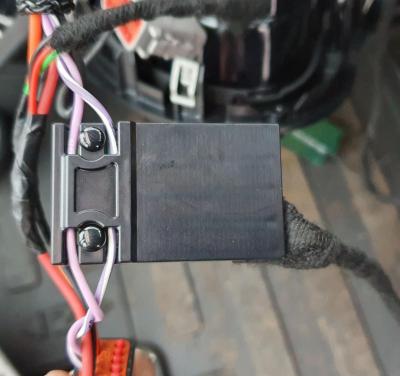- Contactless CAN bus reader -
When connecting external devices to CAN bus in the car or other system, there is always risk of influencing the communication on the bus because of this device. E.g. elementary mistake as incorrectly set bus speed, if the device is not in Listen only mode, disturbs the communication on the bus, thus the car control units report error and the car can be out of order. Listen only mode eliminates this risk, however, the error in software of the connected device or error of device settings/configuration can cause that this mode is not active and communication can be disturbed, e.g. message can be generated at the CAN bus that could have unpredictable consequences – as extreme example.
Other problem that can occur during connection directly to engine-CAN without using FMS gate or similar device approved by manufacturer of the car, is the electrical conductible connection with CAN bus. It violates guarantee conditions for the car and in case of accident, connected device could be considered to be the cause of the accident. On the other hand, connection directly to engine-CAN is in cars without FMS gate (with respect to the unavailability of the gate – cars; or its high price) the only possibility how to read real kilometers, fuel tank level and so on at reasonable expense. In case of modern cars, reading from the engine-CAN provides more data then FMS gate.
CAN sniffer is contactless CAN bus reader. CAN SNIFFER device allows data reading from CAN bus by means of tapping and signal reconstruction at the bus through its scanning from conductors through their insulation. CAN SNIFFER is not conductibly connected with the car bus, thus, the conductors are not disturbed, and communication at this bus cannot be influenced.
CAN SNIFFER output is signal of CAN bus that can be connected to other device that has input of CAN bus, high speed type. Output CAN is of high speed type according to ISO 11898-2. Device works within the speed range of 83.3k … 1Mbit. Scanned CAN can be of high speed type or low speed type. Device works with both variants of CAN. When using conductors of so called low speed CAN (11898-3 and ISO 11992-1), low speed CAN is transformed into high speed CAN at the output. Thus, it is also one-way converter of CAN low speed -> high speed.
If the communication speed of the connected device is incorrectly set, no data is read. “CAN errors” are not sent to the car CAN bus. Short circuit of the CAN at connected device does not show itself at the car CAN.
Contactless CAN SNIFFER 12V / 24V variant contains integrated switching power supply with input power range 8-32 V. Thus, it is not requested to put in external stabilized voltage. Device consumption is 0.13 W.
Dimensions of the device: 68 mm x 20 mm. There is proprietary electronics protected against humidity by means of epoxy layer on one side, and scanning surfaces and MOLEX connector on the other side. This connector can be replaced with 4cable harness upon request. CAN conductors in the car are fixed to the scanning surfaces by means of 2 fixation formulations and 2 plastic rivets. It is not possible to decompose those rivets without damage. After removal and subsequent montage, use new rivets. When using CAN SNIFFER just for short-time measurement, it is possible to use clamping tapes.
| Datasheet |  |
||
| Certificate | |||
 |
 |
||

